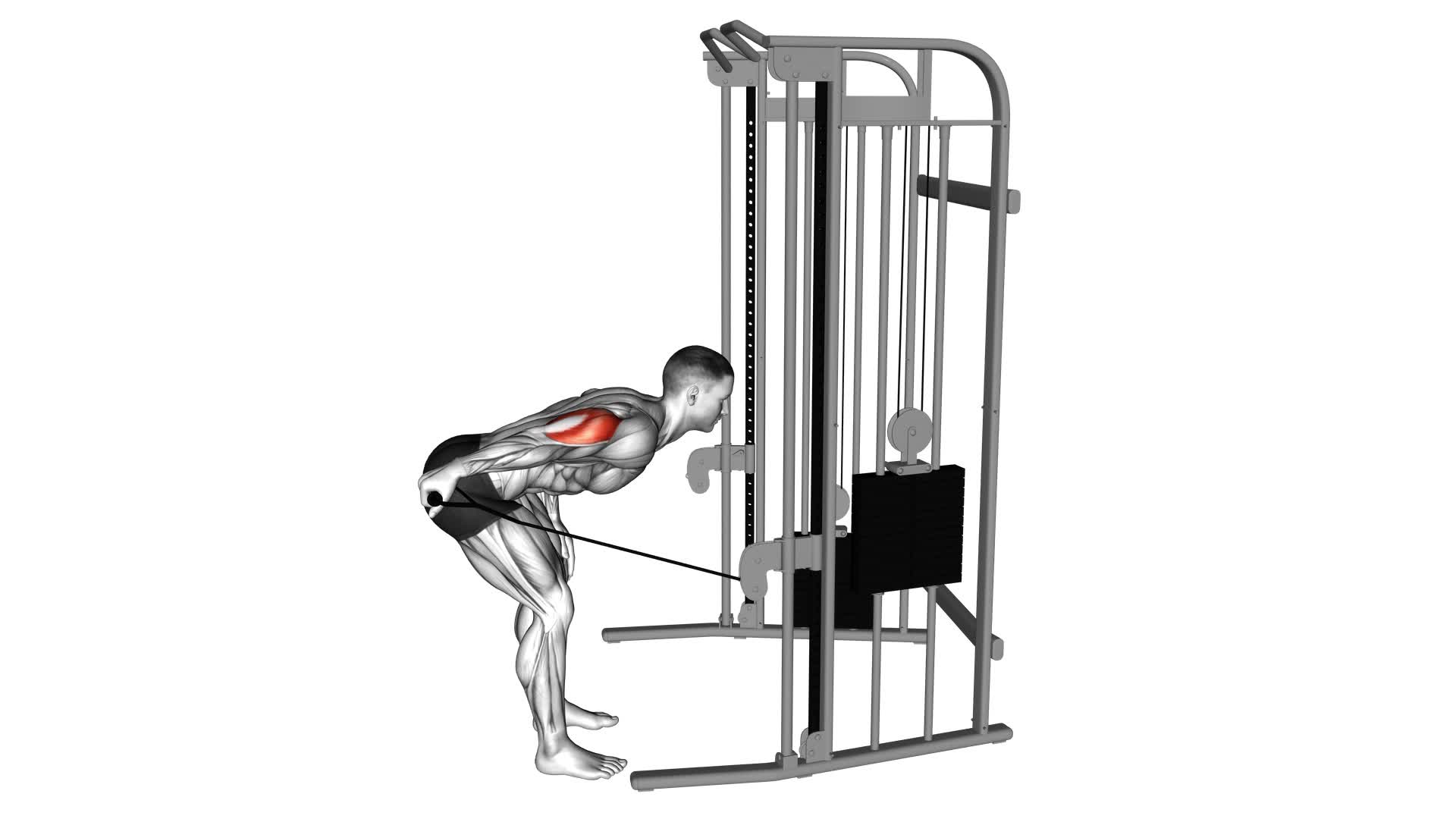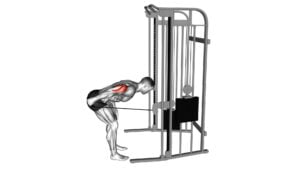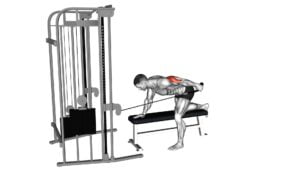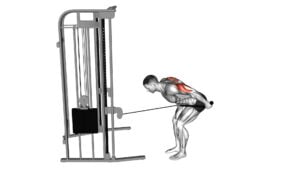Cable Kickback – Video Exercise Guide & Tips

Are you looking for a new exercise to target your glutes and hamstrings? Look no further than cable kickbacks!
Watch This Exercise Video
This video exercise guide will walk you through the proper form and technique, as well as provide tips for maximizing your results.
With variations and modifications available, you can customize this exercise to fit your fitness level and goals.
Get ready to feel the burn and sculpt those lower body muscles like never before!
Key Takeaways
- Cable kickbacks activate and isolate the glute muscles.
- Proper form and technique are crucial for maximizing results and avoiding common mistakes.
- Cable kickbacks can be modified and varied to target different muscle groups and increase intensity.
- Focusing on muscle engagement, control, and proper form is essential for achieving desired results.
Benefits of Cable Kickbacks
To maximize the effectiveness of your cable kickbacks, it's important to understand the numerous benefits that this exercise offers.
Cable kickbacks are a great way to activate your muscles and isolate your glutes. This exercise specifically targets the gluteus maximus, which is the largest muscle in your buttocks. By using the cable machine, you can achieve a more controlled and targeted movement compared to other variations of kickbacks.
The cable kickback activates your glute muscles by creating tension throughout the entire range of motion. This constant tension helps to stimulate muscle growth and development. It also helps to improve muscle activation and engagement, leading to better muscle recruitment during other lower body exercises.
One of the key benefits of cable kickbacks is glute isolation. This exercise primarily targets the glute muscles, allowing you to focus on strengthening and sculpting your buttocks. By isolating the glutes, you can enhance their shape and size, creating a more defined and lifted appearance.
In addition to glute isolation, cable kickbacks also help to improve hip stability and balance. As you perform the exercise, you engage your core and stabilize your hips, which can benefit your overall lower body strength and functional movement.
Proper Form and Technique
To perform cable kickbacks with proper form and technique, start by positioning yourself in front of the cable machine. Follow these steps to ensure you're executing the exercise correctly:
- Attach an ankle cuff to the lowest setting on the cable machine and fasten it securely around your ankle.
- Stand facing the machine, with your feet shoulder-width apart and knees slightly bent.
- Grab the handle with the hand opposite to the leg you're working.
- Keep your core engaged and maintain a neutral spine throughout the movement.
Now, let's address some common mistakes to avoid and focus on maximizing muscle activation:
- Avoid using momentum to swing your leg back. Instead, focus on controlled and deliberate movements.
- Don't lean forward or arch your back excessively. Keep your upper body stable and upright.
- Ensure that your working leg remains straight throughout the exercise. Avoid bending or hyperextending your knee.
- Engage your glutes and squeeze them at the top of the movement to fully activate the muscles.
Equipment and Setup
For the equipment and setup of cable kickbacks, you'll need an ankle cuff and a cable machine. These items are essential for performing the exercise effectively and safely. The ankle cuff is used to attach the cable to your ankle, providing resistance as you extend your leg backward. Make sure to choose a cuff that fits securely around your ankle to avoid any discomfort or slipping during the exercise.
To set up the cable machine, begin by adjusting the height of the pulley. Position it at the lowest point possible to ensure that the cable is at ground level. Attach the ankle cuff to the cable, making sure it's securely fastened. Stand with one foot in front of the machine and the other foot slightly behind you. Grab onto a stable support with one hand to maintain balance.
With the equipment and setup in place, you're now ready to perform cable kickbacks. Remember to engage your core and keep your back straight throughout the exercise. Extend your leg backward, squeezing your glutes at the top of the movement. Slowly return to the starting position and repeat for the desired number of repetitions.
Variations and Modifications
Now let's explore different ways you can modify and vary the cable kickback exercise to target your glutes and lower body muscles even more effectively. Here are some variations and modifications you can try to change up the intensity levels and focus on specific muscle groups:
- Single-leg cable kickback: Perform the exercise with one leg at a time to increase the challenge and target each glute individually. This variation helps improve balance and stability.
- Resistance band cable kickback: Attach a resistance band to the cable machine and loop it around your ankle. This modification adds extra resistance to the movement, making it more challenging and effective for building strength.
- Side cable kickback: Instead of kicking straight back, try kicking your leg out to the side. This variation targets the gluteus medius, a smaller muscle on the side of your glutes that helps with hip stability.
- Cable kickback with pulse: After extending your leg back, pulse it up and down slightly before returning to the starting position. This pulsing motion increases the time under tension for your muscles, enhancing the workout's effectiveness.
Tips for Maximizing Results
To maximize your results, focus on proper form and technique during the cable kickback exercise.
One of the most common mistakes people make is using too much weight, which can lead to improper form and reduced muscle activation. Remember, the goal is to isolate and target the glutes, so using a weight that allows you to maintain control and proper form is essential.
Another mistake to avoid is swinging the leg or using momentum to lift the weight. This not only takes away from the effectiveness of the exercise but also puts unnecessary strain on the lower back. Instead, focus on using your glute muscles to lift the weight and maintain a slow and controlled movement throughout the exercise.
Additionally, make sure to keep your core engaged and your back straight to avoid any unnecessary strain on the spine.
Frequently Asked Questions
How Many Calories Can You Burn by Doing Cable Kickbacks?
You can burn a significant amount of calories by doing cable kickbacks. This exercise targets your glutes and hamstrings, helping to strengthen and tone those muscles.
The more intense your workout, the more calories you'll burn. Cable kickbacks also have the added benefit of improving your balance and stability.
Incorporating this exercise into your routine can contribute to your overall caloric burn and help you achieve your fitness goals.
Can Cable Kickbacks Help in Reducing Cellulite?
Cable kickbacks have numerous benefits that can aid in reducing cellulite. By targeting the glute muscles, cable kickbacks help to tone and firm the area, which can improve the appearance of cellulite.
The technique involves attaching a cable to your ankle and extending your leg backwards against resistance. This exercise also engages the core and improves overall lower body strength.
Incorporating cable kickbacks into your fitness routine can be an effective way to combat cellulite.
Can Cable Kickbacks Be Performed by Beginners?
Yes, cable kickbacks can be performed by beginners. They're a great exercise to target the glutes and help build strength in that area. If you're new to cable kickbacks, start with lighter weights and focus on proper form.
You can also modify the exercise by using ankle weights or resistance bands for added support. Cable kickbacks offer various benefits for beginners, including toning the glutes and improving overall lower body strength.
Are Cable Kickbacks Suitable for People With Knee or Hip Problems?
If you have knee or hip problems, cable kickbacks may not be suitable for you. These exercises can put strain on your joints and worsen your condition.
It's important to adapt your workouts to accommodate your limitations. Instead of cable kickbacks, there are alternative exercises that can target the same muscles without causing discomfort or pain.
Consult with a fitness professional to find suitable cable kickback adaptations or alternative exercises for your knee and hip issues.
Can Cable Kickbacks Be Incorporated Into a Full-Body Workout Routine?
Yes, cable kickbacks can be incorporated into a full-body workout routine. They're a great exercise for targeting the glutes and hamstrings.
To incorporate cable kickbacks into a strength training routine, you can perform them after compound exercises like squats or deadlifts. Additionally, there are variations of cable kickbacks that can target different muscle groups, such as the triceps or deltoids.
Adding cable kickbacks to your routine can help strengthen and tone multiple muscle groups simultaneously.
Conclusion
In conclusion, cable kickbacks are an effective exercise for targeting and sculpting the glutes. By maintaining proper form and technique, using the appropriate equipment and setup, and incorporating variations and modifications, you can maximize your results.
Remember to listen to your body, start with lighter weights, and gradually increase the intensity as you build strength. With consistency and dedication, cable kickbacks can help you achieve your fitness goals.

Author
Years ago, the spark of my life’s passion ignited in my mind the moment I stepped into the local gym for the first time. The inaugural bead of perspiration, the initial endeavor, the very first surge of endorphins, and a sense of pride that washed over me post-workout marked the beginning of my deep-seated interest in strength sports, fitness, and sports nutrition. This very curiosity blossomed rapidly into a profound fascination, propelling me to earn a Master’s degree in Physical Education from the Academy of Physical Education in Krakow, followed by a Sports Manager diploma from the Jagiellonian University. My journey of growth led me to gain more specialized qualifications, such as being a certified personal trainer with a focus on sports dietetics, a lifeguard, and an instructor for wellness and corrective gymnastics. Theoretical knowledge paired seamlessly with practical experience, reinforcing my belief that the transformation of individuals under my guidance was also a reflection of my personal growth. This belief holds true even today. Each day, I strive to push the boundaries and explore new realms. These realms gently elevate me to greater heights. The unique combination of passion for my field and the continuous quest for growth fuels my drive to break new ground.







